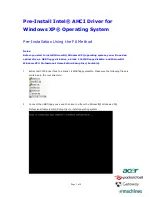
DigiRack Plug-ins Guide
60
Noise Shaping
The Dither plug-in features a technique known
as noise shaping to further improve audio per-
formance and reduce perceived noise in low-
level signals. Noise shaping utilizes filtering to
reduce noise that falls in the middle of the audio
spectrum (specifically, around 4 kHz). This is the
range where human hearing is most sensitive.
In reality, since the noise plays an important
role in reducing quantization artifacts, the noise
is not reduced, rather it is shifted into a fre-
quency range where it is harder to hear. Essen-
tially, noise shaping lessens our perception of
the noise inherent in dithering schemes by
shifting audible noise components into a less
audible range.
Dither and Output Bit Resolution
Dither has two user-selectable settings for opti-
mizing its operation:
Bit Resolution
Use this pop-up menu to choose one of three
possible resolutions for the Dither processing.
As a general rule, set this control to the maxi-
mum bit resolution of your destination.
16-bit
Recommended for output to digital de-
vices such as DAT recorders and CD recorders,
since they have a maximum resolution of 16-
bits.
18-bit
Recommended for output to analog de-
vices if you are using an 18-bit audio interface,
such as the 888 I/O or 882 I/O audio interface;
this is the maximum resolution available from
the 18-bit digital-to-analog convertors of these
devices.
20-bit
Recommended for output to digital de-
vices that support a full 20-bit recording data
path, such the Sony PCM-9000 optical master-
ing recorder, or the Alesis ADAT XT 20. Use this
setting for output to analog devices if you are us-
ing a 20-bit audio interface, such as the
882|20 I/O audio interface. The 20-bit setting
can also be used for output to digital effects de-
vices that support 20-bit input and output, since
it provides for a lower noise floor and greater dy-
namic range when mixing 20-bit signals directly
into the TDM environment.
If you want, you can choose not to use the
Dither plug-in and instead utilize the full 24-bit
resolution of Pro Tools’ digital output, depend-
ing on your destination device. If you are using
a 24-bit audio interface (such as the 192 I/O,
96 I/O, or 888|24 I/O) and are outputting audio
to an analog destination, we recommend that
you do not use dither.
Noise Shaping
This button engages or disengages Noise Shap-
ing. Noise shaping is on when the button is
highlighted in blue. See “Noise Shaping” on
page 60 for more information.
The DigiRack Dither plug-in only provides
eight channels of uncorrelated dithering
noise. If DigiRack Dither is used on more
than eight tracks, the dithering noise begins
to repeat and dither performance is im-
paired. For example, if two Quad DigiRack
Dithers are used, both Quad instances of
Dither will have all of their dither noise un-
correlated. However, any additional in-
stances of the Dither plug-in will begin to
repeat the dithering noise.
Refer to the Pro Tools Reference Guide
for
details on using the Dither plug-in during
mixdown.
Summary of Contents for DigiRack
Page 1: ...DigiRack Plug ins Version 7 3 ...
Page 10: ...DigiRack Plug ins Guide 4 ...
Page 14: ...DigiRack Plug ins Guide 8 ...
Page 36: ...DigiRack Plug ins Guide 30 ...
Page 100: ...DigiRack Plug ins Guide 94 ...
















































